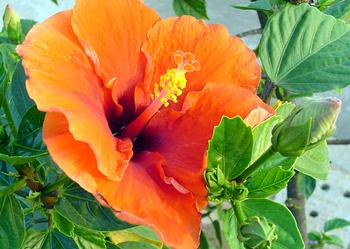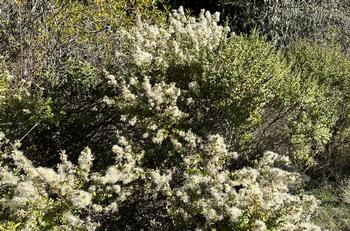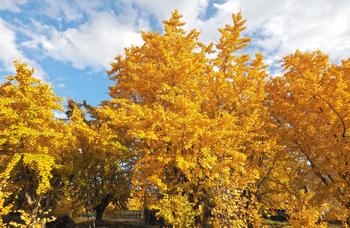The mysteries of plant sex
-
Marty Nelson
-
Sex in the garden is more straightforward for the birds and the bees than it is for the plants. Reproductive processes vary among flowering plants; for many, there is more than one option. When choosing plants for your garden, knowing more about their sexual attributes can help you make better decisions and avoid disappointments.
 Hibiscus flowers are considered perfect because they contain both male and female reproductive parts. Photo: Wikimedia Commons
Hibiscus flowers are considered perfect because they contain both male and female reproductive parts. Photo: Wikimedia CommonsBasic botany lessons often start with identifying a flower's male and female parts. We learn that the stamen is the male reproductive organ, and the pistil is the plant’s female part. The stamen produces and releases pollen. The pistil, usually in the flower's center, consists of a stigma, a style, and an ovary. The ovary contains eggs, which develop into seeds when fertilized by pollen. Flowers that contain both functional stamens and pistils are called perfect flowers. Roses, lilies, tomatoes, and apples are examples of plants with perfect flowers.
Many plants do not produce perfect flowers, and this is where plant sex becomes more complicated. Flowers that lack either stamens or pistils are called imperfect. Flowers with stamens and no pistils are termed staminate or male, and flowers possessing pistils and lacking stamens are considered pistillate or female. To further complicate things, plants with imperfect flowers are classified as either “monoecious” or “dioecious.” Monoecious plants have both male and female flowers on the same plant. Squash is monoecious, and it is easy to tell the female flowers because they have a tiny fruit at the base of the flower. Oak trees are also monoecious. Dioecious plants have male and female flowers on separate plants. The Coyote Brush (Baccharis pilularis) is a common dioecious plant in the Bay Area. The male Coyote Brush produces small yellowish blossoms, while larger white seed-bearing blossoms appear on the female plants. The dioecious Coyote Brush produces male and female flowers on separate plants growing in close proximity. Photo: Marty NelsonOnly plants with perfect or pistillate flowers can produce fruit and seeds. This is desirable in plants with edible fruits but not as popular in landscape plants where fruit or seeds are considered messy. Because plants are also capable of asexual reproduction, it is common to use cuttings to develop cultivars that are clones of a dioecious, male flowering plant. This is how fruitless olive and mulberry trees are produced. In urban landscapes, the preference for neater male trees has raised questions about the possible impact of “botanical sexism.” Several years ago, horticulturist Thomas Ogren theorized that the predominance of male over female trees has increased pollen counts, leading to increasing allergy problems. Although the theory gained some popularity, there is a lack of solid data to support it. Urban-planted trees are far outnumbered by trees existing in nature, and rising pollen counts have instead been attributed to climate change.
The dioecious Coyote Brush produces male and female flowers on separate plants growing in close proximity. Photo: Marty NelsonOnly plants with perfect or pistillate flowers can produce fruit and seeds. This is desirable in plants with edible fruits but not as popular in landscape plants where fruit or seeds are considered messy. Because plants are also capable of asexual reproduction, it is common to use cuttings to develop cultivars that are clones of a dioecious, male flowering plant. This is how fruitless olive and mulberry trees are produced. In urban landscapes, the preference for neater male trees has raised questions about the possible impact of “botanical sexism.” Several years ago, horticulturist Thomas Ogren theorized that the predominance of male over female trees has increased pollen counts, leading to increasing allergy problems. Although the theory gained some popularity, there is a lack of solid data to support it. Urban-planted trees are far outnumbered by trees existing in nature, and rising pollen counts have instead been attributed to climate change. Male flowering ginkgo trees are often planted to avoid the messy fruit dropped by the female flowering trees. Photo: T.Kiya, Flickr
Male flowering ginkgo trees are often planted to avoid the messy fruit dropped by the female flowering trees. Photo: T.Kiya, FlickrDetermining gender is trickier for trees than for other flowering plants. Trees don’t produce flowers or cones until they are sexually mature; depending on the species, this can take years. Trees are also more flexible when it comes to gender concepts and can be classified as “polygamous,” meaning that they have combinations of perfect and imperfect flowers on the same tree. Ash, maple, mulberry, and sumac are examples of polygamous trees. It is estimated that worldwide, 75% of all trees are cosexual, meaning that they produce perfect flowers; 10% are polygamous, 10% are monoecious, and 5% are dioecious. However, in a final twist, some trees can change sex over their lifetime in response to environmental changes. Rather than consider them male or female, we can appreciate that trees use different arrangements of functional sexual parts to reproduce most efficiently.
Does plant sex matter in your garden? We tend to take plant reproduction for granted until we encounter problems like a lack of flowers and fruit or messy tree litter. Understanding your plant’s sexual behavior can help in those situations.



